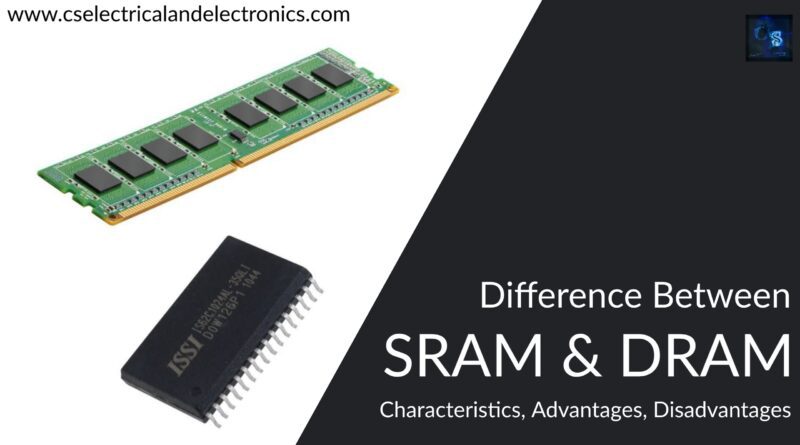Difference Between SRAM And DRAM, Characteristics, Advantages
Hello guys, welcome back to my blog. In this article, I will discuss the difference between SRAM and DRAM, what is SRAM, what is DRAM, characteristics, advantages, disadvantages of SRAM, DRAM.
If you have any doubts related to electrical, electronics, and computer science, then ask questions. You can also catch me on Instagram – Chetan Shidling.
Also, read:
- What Is ADC, How Analog To Digital Converters Works, Types Of ADC
- Top Applications Of CAN, LIN, Ethernet, FlexRay, USB, & Their Speed
- What Is Marx Generator, Working, Circuit Design, Applications
Difference Between SRAM And DRAM
What is RAM?
The information recorded in this sort of memory is lost when the power to the PC or laptop is switched off. The BIOS may be used to examine the information saved in RAM. It’s also known as the main memory, temporary memory, cache memory, or volatile memory of a computer system. In its full form, RAM stands for Random Access Memory.
RAM, or “random-access memory,” is divided into two types: SRAM and DRAM. It saves data from the hard drive for faster access and is manufactured as modules that fit into specific slots on the computer’s motherboard. The more RAM a computer has, the more data it can store and access, which makes it quicker. RAM is called “random” because it permits data to be accessed in any sequence.
What is SRAM?
Transistors retain data and require a steady power supply. SRAM does not need to be updated to recall the data it stores because of the constant power. SRAM is named static because it does not require any changes or actions, such as refreshing, to keep the data intact. It’s a type of memory that’s employed in caches.
Advantages of SRAM
Here, are the pros/benefits of using SRAM:
- In terms of performance, SRAM outperforms DRAM. It indicates that it operates more quickly.
- A speed-sensitive cache is created using SRAM.
- It uses a moderate amount of energy.
Disadvantages of SRAM
Here are the cons/drawbacks of using SRAM:
- It is more expensive than DRAM.
- Because it is volatile, data will be lost if the memory is turned off.
- SRAM does not provide software updates.
- It has a limited amount of storage space.
Characteristics of SRAM
- SRAM is significantly quicker than DRAM.
- DRAMs are many times more costly.
- It takes up a lot more room than DRAMs.
- Power consumption is lower than that of DRAMs.
- Cache type: level 1 or level 2
- Because it does not require a break between accesses, cycle time is substantially shorter than DRAM.
- It’s frequently utilized only as a memory cache.
What is DRAM?
Capacitors are used to store data. Capacitors that hold data in DRAM slowly release energy; if there is no energy, the data has been lost. As a result, to work, a power refresh is necessary regularly. DRAM is named dynamic because it requires regular modification or activity, such as refreshing, to keep the data intact. It is employed in the implementation of main memory.
Advantages of DRAM
Here, are the pros/benefits of DRAM:
- When compared to SRAM, it is less expensive.
- It has a larger capacity for storing. As a result, it’s employed to make a system with more RAM space.
- It has a straightforward structure.
- It is not necessary to update the memory contents.
Disadvantages of DRAM
Here are the drawbacks/cons of using DRAM:
- It is slower than SRAM, which means that accessing data or information takes longer.
- When the power goes out, your data is lost.
- When compared to SRAM, it consumes more power.
Characteristics of DRAM
- Cost-effective
- It has a short data retention period.
- Requires a slower refresh rate than SRAM.
- More energy is consumed.
Difference Between SRAM And DRAM
- When compared to DRAM, SRAM has a quicker access time. The access time of DRAM is longer. It operates at a slower rate than SRAM.
- SRAM is more expensive than DRAM. DRAM is less expensive than SRAM.
- SRAM requires a steady power source but uses less energy. Because the information is stored in the capacitor, DRAM consumes more power.
- SRAM has a low density of packing. DRAM has a high density of packing.
- SRAM is used in L2 and L3 CPU cache units, among other things. In most computers, DRAM serves as the primary memory.
- SRAM has a storage capacity of 1MB to 16MB. DRAM has a storage capacity of 1 GB to 16 GB.
- SRAM is a type of memory that is commonly found on processors or between the main memory and the CPU of a computer. On the motherboard, the DRAM is installed.
- SRAM operates on the notion of shifting current direction via switches. DRAM helps to keep the charges in place.
To summarise, SRAM is called “static” because it keeps each bit of data as long as it is consistently supplied with electricity. This is in contrast to DRAM, which stores data in a “dynamic” manner. The bits of data are stored in DRAM cells, which are made up of a capacitor and a transistor. Unlike SRAM, which requires a steady source of power, DRAM cells must be updated every few milliseconds with a burst of electric power.
SRAM maintains data consistency without requiring the memory module to be updated regularly. As a result, SRAM modules are quicker than DRAM modules in terms of data access. This is why SRAM is employed in applications like video cards and cache memory that demand reasonably quick data access.
I hope this article may help you all a lot. Thank you for reading.
Also, read:
- 100 + Electrical Engineering Projects For Students, Engineers
- 1000+ Electronics Projects For Engineers, Diploma, MTech Students
- 1000+ MATLAB Simulink Projects For MTech, Engineering Students
- 500+ Embedded System Projects For Engineer, Diploma, MTech, PhD
- 500+ Projects For Diploma Electrical, Electronics Student, Diploma Project
- 8051 Microcontroller Timers, TCON Register, TMOD Register
- Advancements In 3D Printing Technology And It’s Future
- Advancements In Power Electronics For Energy Efficiency
Author Profile
- Chetu
- Interest's ~ Engineering | Entrepreneurship | Politics | History | Travelling | Content Writing | Technology | Cooking
Latest entries
 All PostsApril 19, 2024What Is Vector CANoe Tool, Why It Is Used In The Automotive Industry
All PostsApril 19, 2024What Is Vector CANoe Tool, Why It Is Used In The Automotive Industry All PostsApril 13, 2024What Is TCM, Transmission Control Module, Working, Purpose,
All PostsApril 13, 2024What Is TCM, Transmission Control Module, Working, Purpose, All PostsApril 12, 2024Top 100 HiL hardware in loop Interview Questions With Answers For Engineers
All PostsApril 12, 2024Top 100 HiL hardware in loop Interview Questions With Answers For Engineers All PostsMarch 22, 2024Driver Monitoring Systems In Vehicles, Working, Driver Sleepy Alert
All PostsMarch 22, 2024Driver Monitoring Systems In Vehicles, Working, Driver Sleepy Alert








